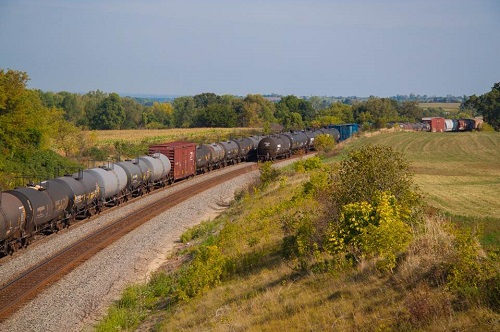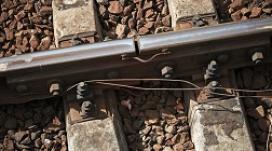Clickety-Clack: A Study on Joint Bar Integrity
The clickety-clack of a train rolling along a railroad is a familiar sound to many people. This unique sound is caused by train wheels passing over rail joints, which are used to hold sections of rail together. The joints are needed in locations where full welded rail is not possible.
Rarely do these joints fail and cause a derailment, but when they do, the consequences can be severe.
To help prevent the conditions that can lead to derailments, Volpe’s David Jeong, Mike Carolan, and Benjamin Perlman worked with Radim Bruzek of ENSCO Inc. and Ali Tajaddini from the Federal Railroad Administration (FRA) to study the structural integrity of joint bars that hold rail sections together. As part of work funded by FRA’s Office of Research and Development, the team surveyed joint bars across the country’s rail system and conducted finite element analyses to understand why, and under what conditions, joint bars are at risk for failure.
Collecting Data from 581 Miles of Rail
Researchers used an optical joint bar inspection system to identify minute defects in the rail joints. As the inspection system moved along the track, it took high-resolution pictures that it analyzed to locate cracks. The system notified an evaluation team, which was following the machine, when it identified a possible joint bar crack. An engineer then examined the area around the crack to identify factors that may have contributed to the crack’s development. At each location, the team noted the amount and type of rail traffic that typically passed over the joint. As a control, the team examined joints that were intact and in good condition.
After collecting data from 581 miles of rail, the team found that cracks in rail joints most likely formed as a result of repeated wheel strikes to the rail ends as they pass over the joint.
Though each pass of a train over a rail joint has a negligible effect, the compounding force of regular train travel over time can fatigue the bars, causing failure. The condition of the joint and supporting track structure can significantly reduce the expected life of a joint if not maintained.
This work was recently presented in two papers at the 2014 Joint Rail Conference in Colorado Springs. Read the papers:
- Engineering Studies on Joint Bar Integrity, Part I: Field Surveys and Observed Failure Modes
- Engineering Studies on Joint Bar Integrity, Part II: Finite Element Analysis
FRA is partnering with the country’s railroads and inspection technology companies, like ENSCO, to find solutions to rail safety issues, including cracked rail joint bars.

Rail tankers such as these are often filled with hazardous materials. (Kathi Kube/Discover Magazine photo)
Recent Joint-Related Accidents

2000: A joint bar failure resulted in several tanker cars releasing hazardous materials, necessitating the evacuation of 3,500 citizens near Eunice, Louisiana.
2002: A broken joint bar caused a derailment that released 200,000 gallons of anhydrous ammonia, a toxic fertilizer, into the town of Minot, North Dakota. The spill caused one death, hundreds of injuries, and prolonged disruption to the town.
2004: Cracked joint bars were blamed for a derailment in Pico Rivera, California, causing the release of 5,000 gallons of diesel fuel.
